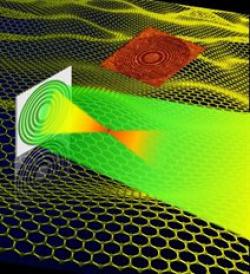Researchers from the University of Birmingham (which lead the research), University of Cambridge and National Centre for Nanoscience & Technology in Beijing designed the world’s thinnest, tunable, lightweight graphene-based lenses.

The project focused on designing Fresnel lenses, which are flat lenses consisting of concentric rings. The rings diffract light to create constructive interference. The other advantage of these lenses is that their optical performance can be tuned by changing the electrical properties of graphene.
The lenses are one atom layer thick, with focusing properties that can be tuned by applying an electric field and by changing the number of graphene layers. The lenses act like microscopic versions of the ones used in lighthouses and could help focus light onto small pixels (for example, in cell phone cameras or a route laser light in computer chips that move data with photons instead of electron).
The researchers built the 50-µm-wide lenses by depositing 0.335-nm-thick layers of graphene on glass (using CVD) and then carved out the concentric circles with photolithography. The graphene rings diffract light as it passes through the lens. The team found that the intensity of the focused light doubled when they went from five-layer to 10-layer versions of the lenses.
The lenses focused 850-nm light, in the near-infrared range; however, the teams are now looking at designing lenses that work at terahertz frequencies, which have promising applications in security, spectroscopy, and biological imaging.